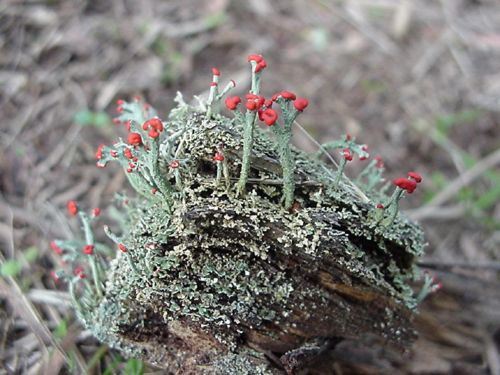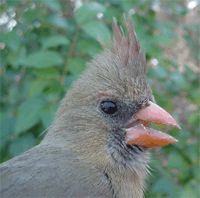 HOME: www.hiltonpond.org |
|
||
|
|
|||
|
|
|||
|
|
|||
|
|
|||
|
|
|||
|
THIS WEEK at HILTON POND |
|
Over the past few weeks, we've devoted weekly essays to different kinds of lichens found at Hilton Pond Center, including crustose and foliose forms. Each of these interesting organisms is a symbiotic combination of a photosynthetic alga (or cyanobacterium) and a fungus. The one remaining major form is called "fruticose"-- hanging or erect lichens that resemble miniature trees.  The most obvious and easily identified fruticose lichen in the eastern United States may be British Soldiers, also called "Matchstick Lichen." (above). This terrestrial gray-green species (Cladonia cristatella) grows on poor, somewhat sandy soil and on old logs or timbers. The bright red tips are fruiting bodies of the fungus.
Some lichens that contain nitrogen-fixing bacteria help add this important element to soil when they die and decay, and many lichens have economic significance as well. Various species produces dyes, serve as food for humans and livestock or pets, and even produce the acid-base indicator in litmus paper. Environmentally, studies show that lichens are accurate indicators of old-growth forests; the greater the variety of lichens, the older the woodland. Lichens also indicate something about air quality. Since they have no root systems, lichens absorb compounds from the atmosphere, but too many airborne minerals--such as in heavily polluted areas--overwhelm the lichens and kill them. In some industrialized zones, lichens that lie downwind from pollution-belching smokestacks have been completely eliminated. Among the fruticose lichens, some are long and beard-like, while others form tiny cups or other ornate structures. Hilton Pond Center is not home to a large number or wide variety of fruticose lichens. The property isn't particularly plagued by poor air quality, but the relative scarcity of lichens reflects the agricultural heritage of the area. A century of logging, row crops, and grazing have all helped to minimize local species diversity--not only for lichens but also for wildflowers, ferns, shrubs, and other flora. If we can keep the air clean in the Carolinas, old-growth diversity may return to our region, so someday we can lay claim to lots and lots and lots of lichens.
Click on the thumbnailed images below to view larger photos of fruticose lichen specimens from Hilton Pond Center. (NOTE: The specimens are not identified to genus or species. If you're positive about identifications of any of the fruticose lichens below, please e-mail WEBMASTER.)
If you enjoy "This Week at Hilton Pond," please help Support Hilton Pond Center for Piedmont Natural History |
|||||||||
 Deer Lichen (right)-- incorrectly called "Deer Moss"-- often grows intermingled with Matchstick Lichen. It is related to Reindeer Lichen, a species that grows in New England and throughout the Canadian tundra where it is a dietary staple for caribou. Closer to home in the Carolinas, Deer Lichen is munched upon by small mammals and, as its name suggests, White-tailed Deer. This lichen species has an unusual use: it is collected and sold to model railroading enthusiasts who paint it dark green to represent trees and shrubs on their tiny train layouts.
Deer Lichen (right)-- incorrectly called "Deer Moss"-- often grows intermingled with Matchstick Lichen. It is related to Reindeer Lichen, a species that grows in New England and throughout the Canadian tundra where it is a dietary staple for caribou. Closer to home in the Carolinas, Deer Lichen is munched upon by small mammals and, as its name suggests, White-tailed Deer. This lichen species has an unusual use: it is collected and sold to model railroading enthusiasts who paint it dark green to represent trees and shrubs on their tiny train layouts.



